40 how to read cholesterol labels
How to read food labels: MedlinePlus Medical Encyclopedia If a label says that a food has 100 mg of sodium, this means it has about 250 mg of salt. You should eat no more than 2,300 mg of sodium per day. This is the amount of sodium that is in 1 measuring teaspoon of table salt. Ask your health care provider if you should have even less. The % daily value is included on the label as a guide. Easy Guide to Understanding Food Labels When You Have ... This means that your food may contain trans-fat even if the food label says 0 gram. Therefore it's important to check the ingredient list (more on this later). Cholesterol guidelines currently recommend having not more than 300 milligrams of cholesterol per day, and if you have heart disease, aim for less than 200 milligrams per day. 2.
How to Read Nutrition Facts Label - Food Network It's not an easy recommendation to understand because, of course, the labels are all in grams. To get an idea of where you roughly want to be when it comes to saturated fat, follow the math ...
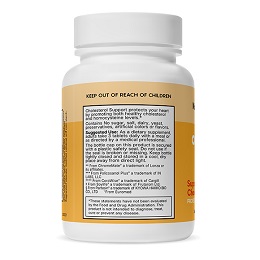
How to read cholesterol labels
PDF Cholesterol Promotora Guide o Bring some empty cans or boxes of popular foods that people often eat. Ask or help people to read the labels and find the amount of cholesterol and fat (such as total fat, saturated fat, trans fat) in a single serving of that food. Practice with the groups using the Activity Sheet on page 14 of the fotonovela. PDF A Guide to Reading Food Labels - University of Rochester daily value may be lower than what is listed on the label. If you eat more than 2,000 calories a day, your daily value may be higher. Remember, 5% DV or less is low and 20% or more is high. Choose foods with a low % DV for fat, saturated fat, trans fat, cholesterol, or sodium. Understanding the Footnote Food Labels: Fat & Cholesterol - HGIC@clemson.edu The Nutrition Facts label shows you how much fat is in a product, even if the fat is hidden as an ingredient. The serving size and the nutrients listed on this label are consistent, which makes it easy to compare similar products without any calculations. % Daily Values (% DVs) are listed in a column on the "Nutrition Facts" label. By looking at these percentages, you easily can determine whether a food contributes a lot or a little of a particular nutrient to your daily diet.
How to read cholesterol labels. How to Understand and Use the Nutrition Facts Label | FDA When looking at the Nutrition Facts label, first take a look at the number of servings in the package (servings per container) and the serving size. Serving sizes are standardized to make it easier... Interactive Nutrition Facts Label Use the Nutrition Facts label as a tool for monitoring consumption of cholesterol. The Nutrition Facts label on food and beverage packages shows the amount in milligrams (mg) and the % Daily Value (%DV) of cholesterol per serving of the food. The Daily Value for cholesterol is less than 300 mg per day. Learning To Read Labels :: Diabetes Education Online On a nutrition food label, subtract the fiber from the total carbohydrate amount. When you read food labels, the grams of sugar are already included in the total carbohydrate amount, so you do not need to count this sugar amount separately. The grams of sugar listed include both natural sugars, from fruit or milk, and added sugars. How to Read Nutrition Facts Labels the Right Way - GoodRx Nutrition Facts labels are required to list the total fat, saturated fat, and trans fats on packaged food products. It's important to choose foods with the right kinds of fats. Here are the differences between the fats you'll see on the label. Bad fats Saturated and trans fats are the less healthy types of fats.
Understanding Food Nutrition Labels | American Heart Association Learn what to look for on the label. 1 - Start with the serving information at the top. This will tell you the size of a single serving and the total number of servings per container (package). 2 - Next, check total calories per serving and container. Should I check the cholesterol on nutrition labels? Dec 16, 2021 — But even if you want to keep your cholesterol intake on the low side, to be conservative, I wouldn't do that with label-reading. Dietary Cholesterol - Nutrition Facts Labels Explained by ... The bloodstream contains two main types of cholesterol: Low-Density Lipoprotein (LDL), known as "bad" cholesterol, and High-Density Lipoprotein (HDL), known as ... Understand your cholesterol test results - HEART UK If you have your cholesterol tested in Europe or the US, they will be measured in milligrams per deciliter (mg/dl). Here's how to convert from one to the other: To convert cholesterol levels: Cholesterol mg/dl = mmol/l x 38.6. Cholesterol mmol/l = mg/dl ÷ 38.6. To convert triglyceride levels: Triglyceride mg/dl = mmol/l x 88.5.
How To Decipher Your Cholesterol Numbers - Piedmont Triglycerides are a type of fat in the blood and are used by the body for energy. However, high triglyceride levels may be a sign of metabolic syndrome and can put you at risk for heart disease. High triglycerides typically result from a diet high in saturated and trans fat, lack of exercise, and/or obesity. How to Read Nutrition Labels: Fat Content, Carbs & What To Look For Total Fat. Nutrition labels are required to include total fat, saturated fat, and trans fat. The total amount of fat in the diet is a percentage of your calorie needs. The recommendation for the typical American diet is around 30%. For someone taking in 2,000 calories, this would mean around 70 grams of total fat per day. How to Read the Nutrition Facts Label on Packaged Foods WebMD gives you tips on how to use the Nutrition Facts food label to help manage conditions like ... high blood pressure, heart disease, and high cholesterol. How to Read Nutrition Labels Like a Pro Jan 14, 2022 — The quick rule is, five per cent DV or less is a little, and 15 per cent DV or more is a lot. (So look for less than five per cent for something ...
How to Tell If Foods Are Low or High Cholesterol All you have to do is use a keyword like "turkey" and click the result. The entry that pops up will have all of a given food's nutrient information, including cholesterol content. What About Fats? In addition to watching the cholesterol content of your foods, you'll probably want to keep tabs on saturated fat and trans fats .
Understanding Your Cholesterol Report - WebMD How to Read Your Lipid Panel A report typically contains the following items, in this order: Total cholesterol : An estimate of all the cholesterol in the blood (good HDL plus bad LDL , for...
How To Read Cholesterol Labels - HealthyCholesterolClub.com The label provides a column of percentages called the percent daily value. It compares how much of a nutrient is in one serving of food to how much of that nutrient you should consume in one day. The percentages are based on a daily diet of 2,000 calories.
PDF How Do I Understand the "Nutrition Facts" Label? Understand the "Nutrition Facts" Label? (continued) • Trans Fat - is also considered a "bad fat" because it can raise your LDL cholesterol and your risk of heart disease. Choose foods with "0" grams of trans fat. Read the ingredient list to avoid foods that contain "partially hydrogenated" oils. Everyone can benefit from limiting
Reading Cholesterol Numbers: The Good & Bad Ratio Tofu - ½ a cup contains 0 milligrams of cholesterol. Beef Liver - 3 ½ ounces contain 389 milligrams of cholesterol. Chicken - Skinless, 3 ½ ounces contain 85 milligrams of cholesterol. These are a few examples of items on the food cholesterol chart, and there are many more food items that you would do well to study up on.
How to Read Food Labels Without Being Tricked - Healthline A good rule of thumb is to scan the first three ingredients, as they make up the largest part of what you're eating. If the first ingredients include refined grains, a type of sugar, or...
How To Read Food and Beverage Labels | National Institute on Aging At the top of the Nutrition Facts label, you will find the total number of servings in the container and the food or beverage's serving size. The serving size on the label is based on the amount of food that people may typically eat at one time and is not a recommendation of how much to eat. Read more about serving and portion sizes.
About Your Cholesterol Poster - Chart to Understand All the Terms and How to Improve Them | $ 16 ...
Cholesterol Test Results & How to Read Them - MedicineNet Cholesterol tests measure total cholesterol as well as HDL and LDL levels in the blood. Triglycerides, another type of fat present in the bloodstream, may also be measured. Cholesterol tests are usually ordered and blood drawn in a doctor's office. There are also home test kits available. It is important to be fasting for the tests to be ...
Interactive Nutrition Facts Label - Accessdata.fda.gov The Nutrition Facts label on food and beverage packages shows the amount in milligrams (mg) and the % Daily Value (%DV) of cholesterol per serving of the food.
How to Read a Nutrition Label: Common Supplement Facts Terms to Know The new labels show total sugar, added sugar, and also the percent daily value of added sugar per serving. Natural sugar is present in foods such as milk (in the form of lactose) and fruit (in the ...
Understanding Cholesterol Levels: LDL, HDL, Total Cholesterol ... - WebMD HDL, high-density lipoprotein cholesterol, or "good" cholesterol Triglycerides, fats carried in the blood from the food we eat. Extra calories, alcohol, or sugar are turned into triglycerides and ...
How to Read Nutrition Labels - Frederick Health Use the percent daily value (%DV) as a tool to see if there's too much or too little of a specific nutrient. Less than 5% is considered too little, and more than 15% is a lot. Most often, choose foods that are higher in %DV for dietary fiber, vitamin D, calcium, iron, and potassium.
How to read food labels | healthdirect The label will tell you: the name of the product, describing accurately what it is the brand name what ingredients it contains (listed in order from largest to smallest by weight) nutritional information (such as average amount of energy, fat, protein, sugars and salt)
How to Read Food Labels for a Heart-Healthy Diet Be on the watch for both trans fats and hydrogenated oil in ingredients lists. Trans fats, which raise bad cholesterol levels, aren't listed as such in the ingredients. Rather, you have to watch for ingredients that contain trans fats, mainly hydrogenated oil and partially hydrogenated oil. Canola and olive oil don't contain trans fats.
Food Labels: Fat & Cholesterol - HGIC@clemson.edu The Nutrition Facts label shows you how much fat is in a product, even if the fat is hidden as an ingredient. The serving size and the nutrients listed on this label are consistent, which makes it easy to compare similar products without any calculations. % Daily Values (% DVs) are listed in a column on the "Nutrition Facts" label. By looking at these percentages, you easily can determine whether a food contributes a lot or a little of a particular nutrient to your daily diet.
PDF A Guide to Reading Food Labels - University of Rochester daily value may be lower than what is listed on the label. If you eat more than 2,000 calories a day, your daily value may be higher. Remember, 5% DV or less is low and 20% or more is high. Choose foods with a low % DV for fat, saturated fat, trans fat, cholesterol, or sodium. Understanding the Footnote
PDF Cholesterol Promotora Guide o Bring some empty cans or boxes of popular foods that people often eat. Ask or help people to read the labels and find the amount of cholesterol and fat (such as total fat, saturated fat, trans fat) in a single serving of that food. Practice with the groups using the Activity Sheet on page 14 of the fotonovela.





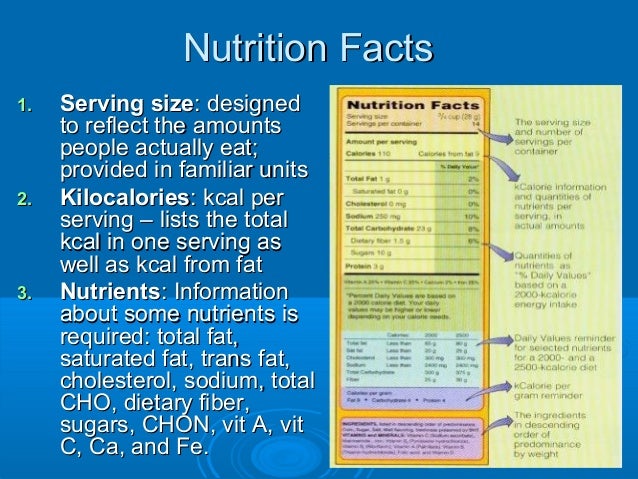
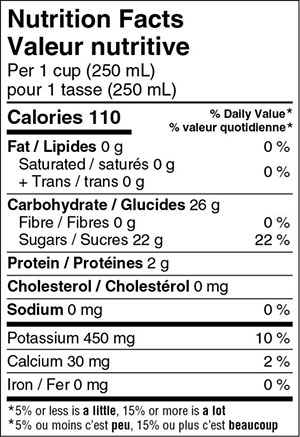
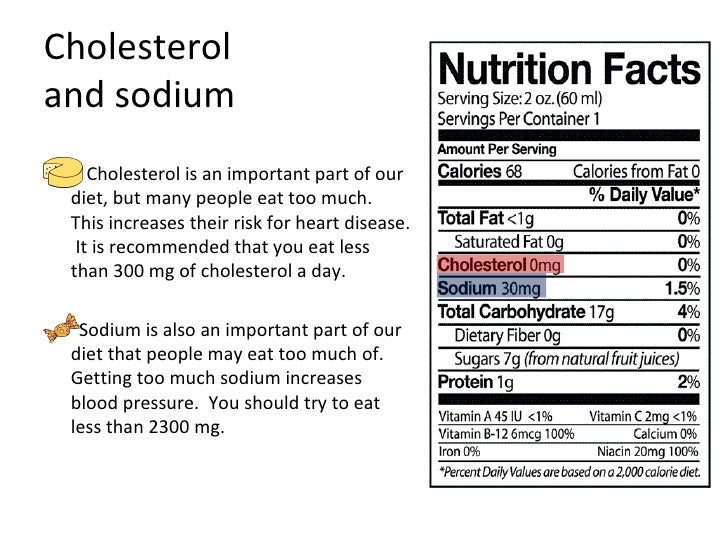






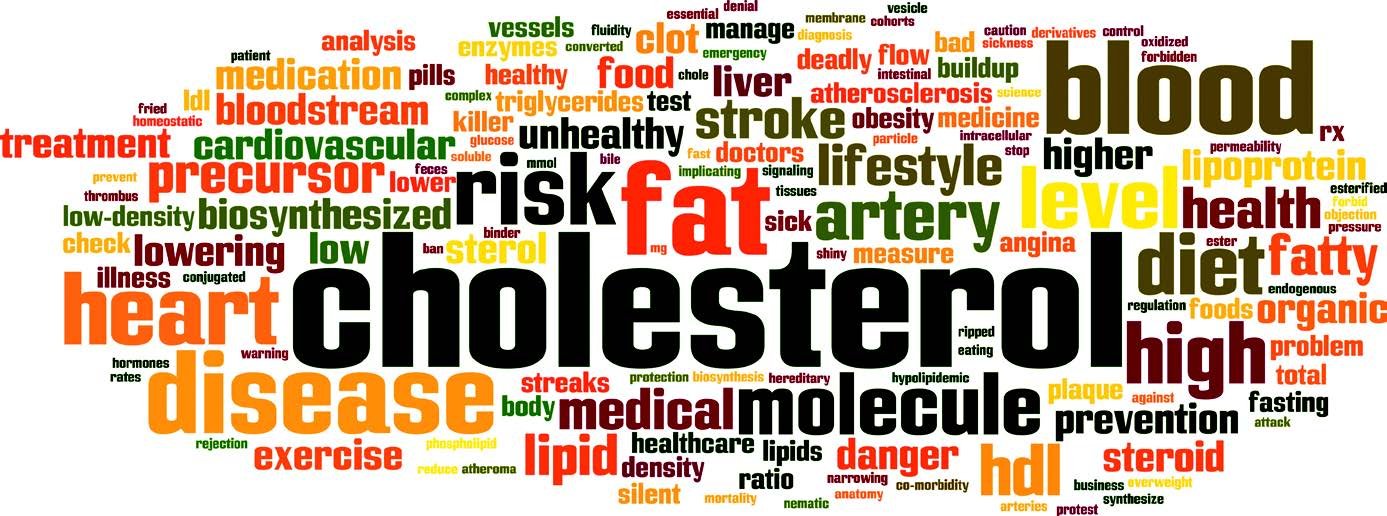
Post a Comment for "40 how to read cholesterol labels"